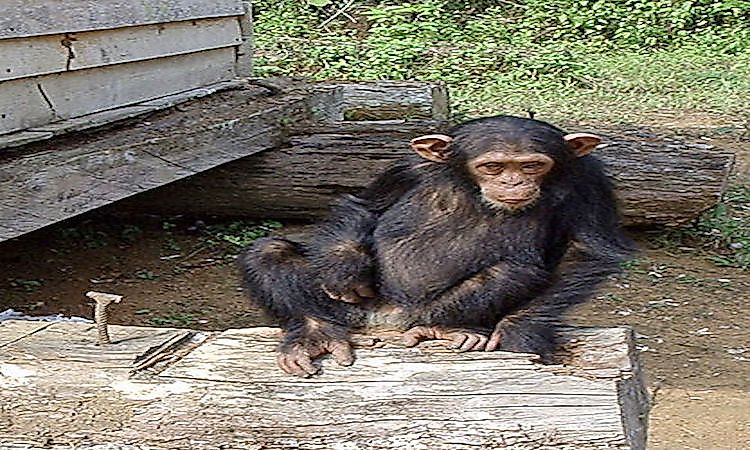Mali's Endangered Mammals

The country of Mali is a landlocked country that is found in Western Africa and is one of the larger countries in Africa. The majority of Mali, around 65%, is covered in desert or semi-desert, while the rest is either forest or savanna. Mali has a number of endangered mammals that live in the country, as well as in other countries in the region. This article will discuss some of these mammals and their physical characteristics, habitat and ranges and their current conservation status.
The endangered mammals of Mali:
Common Chimpanzee
The Common Chimpanzee, scientific name Pan troglodytes, is a species of great ape that is a member of the Hominidae family of great apes. Adults males of the species usually weight between 88 to 132 pounds (40 to 60 kilograms) and are usually around 5.3 feet (1.6 meters) tall when standing. Adult females are smaller than males usually weighing around 71 to 104 pounds (32 to 47 kilograms) and standing at about 4.3 feet (1.3 meters). The species is mostly covered in rough black hair, except for its face and most of the hands and feet which have no hair. The habitat of these animals is in the various forest of Africa, like primary moist lowland forest, secondary moist lowland forest, swamp forest, submontane forest, montane forest, dry forest and savanna woodland. This species is found from southern Senegal to the northern part of the Congo River and into western Tanzania and western Uganda. The species have the widest geographic distribution of any species of great ape on the planet. According to the International Union for Conservation of Nature (IUCN) Red List, the Common Chimpanzee has been listed as an endangered species since 1996, and its population has been declining. The major threats that this species faces are from poaching, habitat loss and degradation from agriculture and infrastructure and infectious disease.
Dama Gazelle
The Dama Gazelle, scientific name Nager dama (was formerly Gazella dama), is a species of gazelle that is a member of the Bovidae family of all cloven-hoofed, ruminant mammals. The adult of this species grows to be around 35 to 47 inches (90 to 120 centimeters) tall and weight anywhere between 77 to 165 pounds (35 to 75 kilograms). The species is white and has a tan-brown colored head and neck and curved, ringed horns. The horns of adult males grow to be around 14 inches (35 centimeters), while the horns on females are a lot shorter. This species habitat is in the grasslands of the Sahelian region, sub-desert steppes and in thinly wooded savanna. This species is native to Chad, Mali, and Niger and is also found in Algeria and Morocco, although it may be regionally extinct in those two countries. According to the IUCN Red List, the Dama Gazelle has been listed as a critically endangered species since 2006, and its population has been declining. The major threats that this species faces is from unchecked hunting, habitat loss, and degradation from the overgrazing and expansion of livestock and from prolonged droughts.
Rhim Gazelle
The Rhim Gazelle, scientific name Gazella leptoceros, is a species of gazelle that is also a member of the Bovidae family. The adults of this species grow to be around 40 to 46 inches (101 to 116 centimeters) in length. This species has a pale or cream colored upper body, and its lower body and legs are a white or pale color. The horns of the species are slim and slightly curved. This species is mostly found in dunes and interdunal depressions, although it will long ways to find vegetation. This species is native to Algeria, Chad, Egypt, Libya, Mali, Niger, Sudan, and Tunisia. According to the IUCN Red List, the Rhim Gazelle has been listed as an endangered species since 2008, and its population has been declining. The major threats that this species faces is from hunting, poaching, desertification and the disturbance and degradation of its habitat.
Steps Taken To Protect The Wildlife Of Mali
There are steps that the government of Mali and the greater international community have taken to help the endangered mammals in the country. The government of Mali has set up four different national parks across the country to help protected endangered species and their habitats. There are some mammals, like the Common Chimpanzee, which are protected under the African Convention on the Conservation of Nature and Natural Resources, as well as by laws passed by the government of Mali and the international community.
Mali's Endangered Mammals
| Mali's Endangered Mammals | Scientific Name |
|---|---|
| Northwest African Cheetah | Acinonyx jubatus hecki |
| West African Lion | Panthera leo senegalensis |
| West African Wild Dog | Lycaon pictus manguensis |
| Dama Gazelle | Gazella dama |
| Addax | Addax nasomaculatus |
| Common Chimpanzee | Pan troglodytes |
| West African Giraffe | Giraffa camelopardalis peralta |
| Rhim Gazelle | Gazella leptoceros |











